chesapeake bay
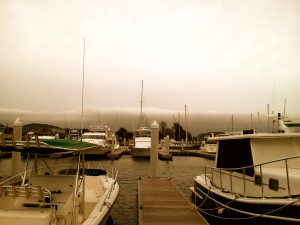 Last year I entertained myself during Hurricane Irene by blogging about the storm, so I thought I’d do it again with Sandy. While some storm tracks have Kent Island directly in the path of the storm, it looks more likely that it will come ashore about 60 miles north of us. That’s too close for comfort with a storm this big. As of 3:00 PM Sunday, we are just starting to see the first bands of the hurricane. It’s raining lightly and winds are from the northeast sustained at 29 knots at Thomas Point Light on the Chesapeake Bay. If the storm stays north as projected, I don’t expect a strong storm surge. Tides were pretty high last night, but the northeast wind will actually push water out of the Bay. We might even seen record low water, so I’m standing by with my relic hunting gear just in case some of the colonial sites and shipwrecks are exposed. Our biggest concern is trees and limbs coming down and flooding from the expected heavy rains. Since this is a fishing site, I’ll also report that fishing was not particularly good yesterday although we did catch a few on topwater in the Eastern Bay shallows. Stay tuned and I’ll do my best to keep you in the loop about the storm.
Last year I entertained myself during Hurricane Irene by blogging about the storm, so I thought I’d do it again with Sandy. While some storm tracks have Kent Island directly in the path of the storm, it looks more likely that it will come ashore about 60 miles north of us. That’s too close for comfort with a storm this big. As of 3:00 PM Sunday, we are just starting to see the first bands of the hurricane. It’s raining lightly and winds are from the northeast sustained at 29 knots at Thomas Point Light on the Chesapeake Bay. If the storm stays north as projected, I don’t expect a strong storm surge. Tides were pretty high last night, but the northeast wind will actually push water out of the Bay. We might even seen record low water, so I’m standing by with my relic hunting gear just in case some of the colonial sites and shipwrecks are exposed. Our biggest concern is trees and limbs coming down and flooding from the expected heavy rains. Since this is a fishing site, I’ll also report that fishing was not particularly good yesterday although we did catch a few on topwater in the Eastern Bay shallows. Stay tuned and I’ll do my best to keep you in the loop about the storm.
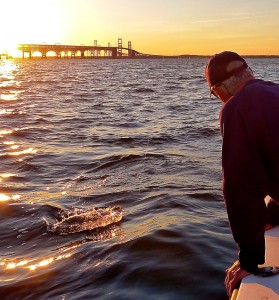 We’ve caught some very nice fish on Thunder Road over the past couple of weeks. Whether in the shallows or on the ledges, it’s fall on the Chesapeake Bay and time for trophy striped bass.
We’ve caught some very nice fish on Thunder Road over the past couple of weeks. Whether in the shallows or on the ledges, it’s fall on the Chesapeake Bay and time for trophy striped bass.
It’s a hot bite tonight. I’m fishing alone throwing topwater, a big chunky blue and silver Stillwater Smackit. Not my favorite plug, but pretty damn close. If you’ve read my book, you know where I am. If you haven’t, turn to page 50 in this month’s Chesapeake Bay Magazine and in his article, “Autumn Angling,” John Page Williams will tell you exactly where.
I’m right where John Page says I’ll be, working well inside the eight-foot-deep mark where the rocks come up to four. It’s a windy evening, too windy for topwater, but the bite is on and the fish don’t care.
There’s a full-moon-outgoing, so lots of current, too much current to stay over the spot for very long. The wind is blowing 17 knots from the northeast and building ahead of an approaching cold front. I’m drifting across the rocks way too fast. I compensate by slinging my lure as far as I can to lengthen my angle of attack. I imagine my fishing spot as a giant rectangular canvas with my lure painting a streak from the top corner to the bottom. The fish won’t hit unless I’m working the surface within four feet on either side of the underwater rocks. Unlike jigging where we work with portrait strike zones, for topwater, they’re landscape. Read More!
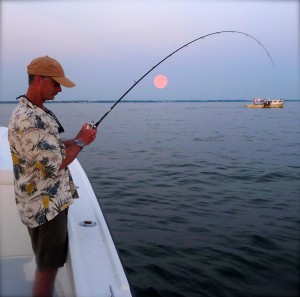 If there is ever a season when it’s necessary to pull out all the stops in order to catch nice striped bass in the Chesapeake Bay, it’s late summer. There are plenty of small fish to be caught, but getting the bigger ones takes a lot more effort. In my presentations this year, I’ve advised fishermen to take what they know about the five reasons why striped bass bite – hunger, reaction, competition, territory, and curiosity – then consider the five senses fish employ when feeding – sight, smell, sound, feel and taste – and fashion their fishing techniques to maximize their chances. In other words, 5 X 5 = success.
If there is ever a season when it’s necessary to pull out all the stops in order to catch nice striped bass in the Chesapeake Bay, it’s late summer. There are plenty of small fish to be caught, but getting the bigger ones takes a lot more effort. In my presentations this year, I’ve advised fishermen to take what they know about the five reasons why striped bass bite – hunger, reaction, competition, territory, and curiosity – then consider the five senses fish employ when feeding – sight, smell, sound, feel and taste – and fashion their fishing techniques to maximize their chances. In other words, 5 X 5 = success.
When fish are hungry and feeding aggressively, they’re easy to catch. Fishermen who are lucky enough to find a school of hunger feeding fish blitzing beneath screaming birds are certain to be successful, no matter what kind of lures they use. Unfortunately, it’s not easy to find bigger fish feeding on the surface this time of year. I’m very envious of the few fishermen I know who have the time and money to chase blitzing rockfish all up and down the East Coast. Since most of us have to go fishing close to home in the limited time we have available, we have to look diligently for the few good stripers that might be around. When we’re lucky enough to find them, we usually have to work hard to convince them to take our lures. Sometimes, they just don’t want to bite. Read More!
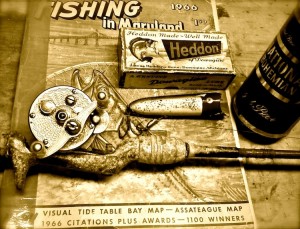 To look backward for a while is to refresh the eye, to restore it, and to render it more fit for its prime function of looking forward. ~ Margaret Fairless Barber
To look backward for a while is to refresh the eye, to restore it, and to render it more fit for its prime function of looking forward. ~ Margaret Fairless Barber
Sometimes I think that all I know about life comes from fishing. Other interests have waxed and waned, but the one constant, the fundemental source from which I draw strength and inspiration is the time I spend in pursuit of the perfect cast. It’s taught me a lot about life, the laws of nature, and basic principles of human interaction. I can’t recall my first boat ride, my first cast, or the first fish I caught because I can’t remember a time when any of those things were absent. Lately, as part of my Chesapeake Light Tackle mini book tour of Chesapeake Bay regional fishing clubs, bait shops, etc., I’ve been talking a lot about how science is gradually confirming what fishermen have known for generations. It almost seems like the more we learn by scientific observation, the more we confirm what fishermen have always accepted as fact. For example, most of the more than two-thousand anglers I’ve had the privilege to talk to recently were probably amused to learn that striped bass have a 50Hz visual flicker fusion frequency that is slightly slower than that of humans, but I haven’t encountered very many fishermen who are surprised when they hear that, as a result, the colors the fish see best in good light are chartreuse and white. Read More!
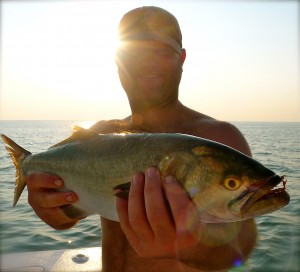 Not long ago we took breaking bluefish and rockfish for granted in the Chesapeake Bay. Unfortunately, times have changed. Since there are a lot fewer fish now, we have to look a lot harder and longer for summer breakers. Granted, it’s easier on some days than it is on others. In my book, Chesapeake Light Tackle, An Introduction to Light Tackle Fishing on the Chesapeake Bay, I dedicate several pages to methods for locating breaking fish. The best strategy for finding blitzing fish under working birds is to head straight for the closest oyster bar. In my reports, I often mention that I find fish over live, hard bottoms. By that, I mean places where there are active shellfish populations.
Not long ago we took breaking bluefish and rockfish for granted in the Chesapeake Bay. Unfortunately, times have changed. Since there are a lot fewer fish now, we have to look a lot harder and longer for summer breakers. Granted, it’s easier on some days than it is on others. In my book, Chesapeake Light Tackle, An Introduction to Light Tackle Fishing on the Chesapeake Bay, I dedicate several pages to methods for locating breaking fish. The best strategy for finding blitzing fish under working birds is to head straight for the closest oyster bar. In my reports, I often mention that I find fish over live, hard bottoms. By that, I mean places where there are active shellfish populations.
I typically plan all my fishing trips so that I keep my boat over as many oyster bars as possible. That includes when I’m just running from one place to another. For fish to feed on the surface in the Chesapeake Bay they need three primary ingredients. In the book, I abbreviate the formula like this: C + B/HB = BF. That’s current plus bait over hard bottoms equals breaking fish. Read More!
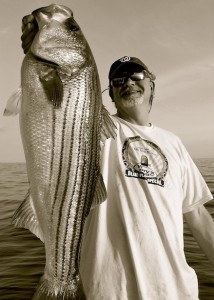 “There are no more deserts. There are no more islands. Yet there is a need for them. In order to understand the world, one has to turn away from it on occasion; in order to serve men better, one has to hold them at a distance for a time. But where can one find the solitude necessary to vigor, the deep breath in which the mind collects itself and courage gauges its strength? There remain big cities.” -ALBERT CAMUS from THE MINOTAUR.
“There are no more deserts. There are no more islands. Yet there is a need for them. In order to understand the world, one has to turn away from it on occasion; in order to serve men better, one has to hold them at a distance for a time. But where can one find the solitude necessary to vigor, the deep breath in which the mind collects itself and courage gauges its strength? There remain big cities.” -ALBERT CAMUS from THE MINOTAUR.
I must apologize for the lack of fishing reports lately. I’ve required some time to concentrate on other interests, dance for a while to the songs in my head, and step back to reassess some priorities after over-extending a little. I’m currently writing from a boat off the Florida Keys. I’ve been here for the past ten days or so. It’s been relaxing, rejuvenating actually, and I’ve enjoyed some successful fishing. My time for tuning out is about over, so next week I’ll be back working in the big city, and perhaps more importantly, back in the swing of the Chesapeake fishing scene. On August 20th I’ll speak to the Broadneck/Magothy MSSA chapter about Strike Triggers and Catch & Release techniques. The following night, August 21st, I’ll travel to the Essex/Middle River chapter to present a similar talk. On August 25th and 26th I’ll have a book-signing table and also give a couple of talks at the 6th Annual Maryland Buck Wild Outdoors Expo. Look for me all day Saturday and Sunday. Read More!


